
Combined with the characteristics of titanium alloy and the structural characteristics of the frame-like titanium alloy, this paper briefly introduces the aspects of process plan planning, processing equipment selection, tooling design ideas, common tool types and processing considerations.
Frame type titanium alloy parts processing scheme
For titanium-based parts of the frame, the titanium alloy casing is common (see Figure 1). According to the different requirements of the product and its processing characteristics, there are currently four main processes: 1 segment finishing, re-welding, and then processing the welded joint parts. 2 segment roughing, re-welding, and then overall CNC finishing. 3 overall forging, and then coarse machining. 4 overall casting, and then coarse machining.
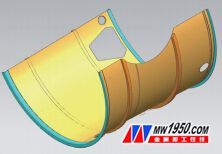
Selection of machining equipment for frame-type titanium alloy parts <br> If the method of segmented finishing, re-welding, and re-processing of welded joints is adopted, the processing equipment can select the appropriate five according to the contour size of the parts according to the condition of the welded joints. Face gantry machining center, large five-axis linkage machining center or CNC lathe.
If segmented roughing, re-welding, and overall CNC finishing are used, the frame-like titanium alloy parts using such a process plan are generally large in size, complicated in structure, have many welds, and are easily deformed by welding, so before welding Generally, there are more margins on the end faces and surfaces. When planning the finishing process, it is necessary to transfer the process as little as possible, because once the process is too much, the cumulative error and the deformation factor of the product are difficult to control. Generally speaking, it is recommended to select a large gantry turning and milling compound center (see Figure 2 and Figure 3). Secondly, it is recommended to use CNC lathe and five-axis linkage machining center (see Figure 4) for joint processing.
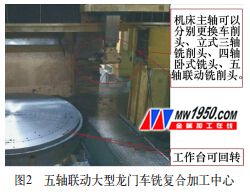
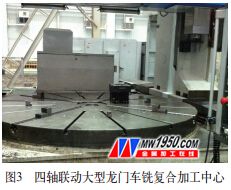
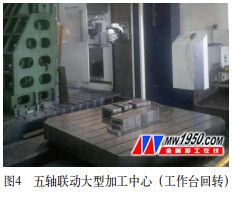
If it is a whole forging (casting), and then coarse and fine machining. The blank of the parts prepared by this process scheme has a relatively uniform machining allowance and a relatively small removal margin, which can shorten the machining time. In the machining process, considering the inner wall, outer wall and surrounding window of the frame parts, rough finishing is required. For this reason, when selecting the processing equipment, you should select the appropriate CNC lathe (turning roughing) and the large gantry five-axis machining center (inside). The outer wall is rough and the surrounding window is machined, and the large gantry turning and milling center is used for finishing.
Design Ideas for Machining Tooling of Frame Titanium Alloy Parts
Considering that the frame-like titanium alloy parts are generally thin-walled, easily deformed, and complicated in structure, according to their structural analysis, the following basic principles must be observed in the tooling-assisted design.
(1) It satisfies the stability and reliability of the workpiece positioning during the use of the tooling, has sufficient bearing or clamping force, and has a rigid structure suitable for the part.
When roughing, the clamping force can be large to prevent the parts from loosening during the large cutting process with large cutting width and depth. When finishing, consider the parts to be easily deformed, and the clamping force of the tool should be slightly smaller, but Prevent the workpiece from loosening. For the extremely easy-to-deformed parts of the thin-walled structure, it is necessary to appropriately increase the auxiliary supporting tooling structure.
(2) Make full consideration of the unity or association between the part design basis (use benchmark), the tooling positioning benchmark, and the part inspection benchmark.
(3) It is simple and quick to operate in the process of clamping.
(4) It can satisfy the reliable repeatability of the tooling during the adjustment, the order of replacement or the replacement process.
(5) Avoid the complicated structure and cost as much as possible, and strictly follow the principle of manual, pneumatic, hydraulic, and servo priority design.
(6) It is necessary to design a limit anti-rotation device in the circumferential direction to prevent the secondary clamping from having a circumferential reference. If the batch size is large, pneumatic and hydraulic automatic fixtures can be designed to realize the automatic position and automatic return compression of the pressing block during processing. If it is a side slot (hole) and other conditions that may be cut into the tooling when machining the part, generally, the design should consider the appropriate position. The better solution is to recommend the matching part of the tool to be the same as the part. Material to avoid quality accidents caused by damage to the tool.
For parts where the precision requirements of thin-walled frame titanium alloy parts are high, the tooling of the tooling may cause new deformation of the parts. Because during the cutting process, the fluctuating effect between the cutting force and the clamping force will cause coupling, resulting in additional stress of improper clamping, residual stress after cutting, and residual stress inside the workpiece, which will be distributed again after the tool is unloaded. Produces new deformations after processing. For this purpose, it is recommended to use the "transition shape adjustable support" or "transition shape flexible tooling" method (see Figure 5), which is adjustable according to the shape of the part transition shape in the free state. (Flexible) supported and clamped.
For the processing of the inner wall of large thin-walled titanium alloy parts, more from the perspective of cost saving, it is generally used to combine the shape of the bowl-shaped bag holder with the core setting (see Figure 5, Figure 6). Effectively achieve reliable tooling.
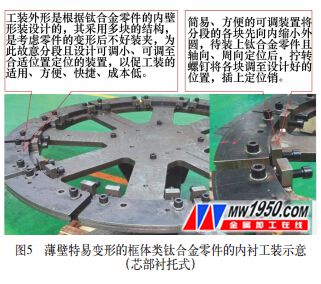
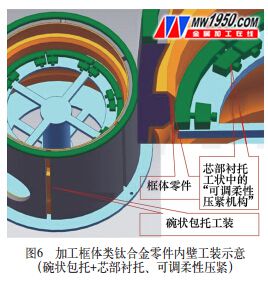
Selection of common tool types for machining of frame titanium alloy parts
From the three comprehensive factors of improving efficiency, improving quality and reducing cost, the tool for processing frame titanium alloys is expected to have high hot hardness and good wear resistance; it is desirable to have good impact resistance. It is also desirable to have better toughness; it is desirable to have a higher thermal conductivity and a lower chemical activity. From these hopes, the tool materials commonly used in the processing of titanium alloys are mainly cemented carbide, polycrystalline diamond (PCD) and polycrystalline cubic boron nitride (PCBN). Through practical production verification, cemented carbide and PCD tools are considered to be ideal tool materials for processing titanium alloys.
At present, the most preferred and most widely respected tool materials for processing titanium alloys are carbide tools. Because cemented carbide has the characteristics of relatively low cost, good thermal conductivity, high hardness, good toughness and red hardness. According to its chemical composition, it can be divided into tungsten-cobalt (YG), tungsten-cobalt-titanium (YT) and rare-type carbides (YW). At present, it is still widely used in industrial production, and it is still tungsten-cobalt-based hard alloy YG8. , YG6, YG3, etc. For example, YG8 inserts are usually used for roughing and intermittent turning, YG3 inserts for finishing and continuous turning, and YG6 inserts for general machining. If the fine-grained carbide YA6, YD15, YG10H, YS2, etc. of the rare metal added are used, the life and processing efficiency of the tool can be improved. The reason why tungsten-cobalt-titanium (YT)-based cemented carbide tools are not used in practice is that the YT-type inserts contain titanium, which has a strong affinity with the processed titanium alloy and quickly sticks the tip.
Carbide processing of titanium alloy speed can reach more than 45 m / min, but when the cutting speed continues to increase, the temperature of the contact surface of the tool and the workpiece rises rapidly, and because of the lower melting point of Co, the high cutting temperature and element diffusion Under the action, the diffusion and loss of W and Co elements in the tool material are reduced, the hardness and toughness of the tool are reduced, and the cemented carbide tool undergoes severe plastic deformation, adhesive wear and diffusion wear, resulting in tool failure. Therefore, carbide tools are only suitable for titanium alloys with a cutting speed of less than 75 m/min.
Polycrystalline diamond tools have extremely high hardness and high wear resistance. They also have high elastic modulus, high thermal conductivity, sharp edge, low friction coefficient and low affinity with non-ferrous metals. These tools are suitable for finishing and super finishing of titanium alloys.
Polycrystalline cubic boron nitride (PCBN) cutters, although slightly lower in hardness than diamonds, have a much better thermal stability than diamonds and can reach temperatures above 1 200 ° C (the heat resistance temperature of diamonds is only 700). ~800 ° C), chemically inert, and no chemical reaction with titanium alloy at 1 200 ° C. Compared with cemented carbide tools, PCBN tools have the characteristics of high cutting speed, good surface roughness and long tool life. Therefore, PCBN tools are more suitable for finishing titanium alloys. However, due to the high brittleness of the PCBN tool, it is necessary to avoid intermittent cutting or sudden cutting in the cutting process.
Other precautions for the machining of frame-type titanium alloy parts <br> Without seeking a high cutting speed, it is only necessary to increase the cutting amount reliably. Excessive cutting speeds can lead to overheating of the cutting edge, edge sticking and severe wear and tear. The change of the amount of the cutter does not change the temperature significantly, so reducing the cutting speed and increasing the cutting amount is a reasonable and suitable cutting method.
In order to improve the heat dissipation conditions and enhance the cutting edge during turning, the rake angle is generally 5 ° ~ 9 °; in order to overcome the friction caused by rebound, the flank of the cutter body is generally 10 ° ~ 15 °; when drilling By shortening the length of the drill bit, increasing the thickness of the core and the amount of the guide cone, the durability of the drill bit can be increased several times.
Indispensable cutting fluid, and water-soluble cutting fluid is suitable. However, it is not possible to use cutting fluids containing chlorine or other halogens and sulfur. Such cutting fluids can adversely affect the mechanical properties of titanium alloys.
For the easily deformable titanium alloy frame parts, before the numerical control finishing, it is recommended to carry out detailed measurement in principle, and carefully analyze the redistribution machining allowance and re-calibrate the machining coordinates according to the measurement results.
The milling process is three-axis machining after three-axis machining, and the hole machining is performed after the first machining. Maintain the uniformity of the NC programming coordinate system and try to merge the processes to reduce the turning. All tools, fixtures, etc. that come into contact with the titanium alloy must be cleaned in advance. For cleaned titanium alloy parts, to prevent grease contamination, the operator or the inspector should wear clean gloves for operation or inspection.
Travel Models,Traffic Demand Modeling,Transport Demand Model,Four Step Transportation Model
Nanjing Great Century Art Model Co., Ltd. , , https://www.dsjysmx.com